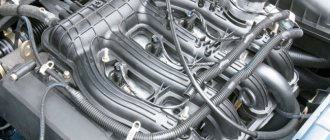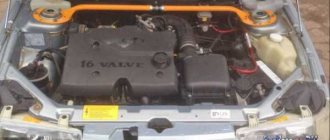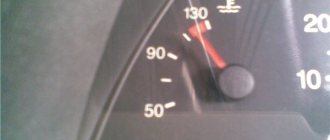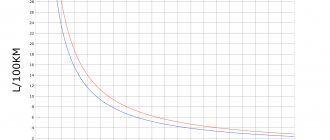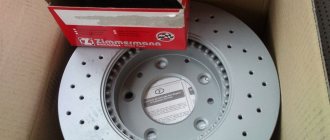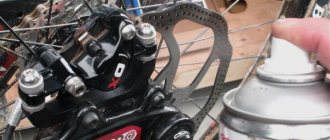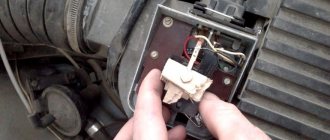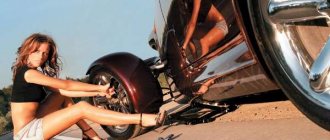General features of the problem
The whole insidiousness of the situation lies in the fact that vibration of the steering wheel when driving is, if not the most common, then quite an annoying problem. It usually creeps up unnoticed when you don’t pay attention to it at first, but at one fine moment the beating can already be felt throughout the whole car. And at this moment we understand that we have gradually become accustomed to this obsessive defect and therefore are in no hurry to eliminate this problem. And in vain.
In the long term, vibration can result in significant repair costs. Therefore, it is in the interests of the owner himself to determine the source and causes of the malfunction. To get started, just perform a number of simple operations:
- drive a car along the highway and feel the level of beats at various speeds;
- notice at what speed the vibration effect begins and at what speed it disappears;
- check for shaking of the steering wheel when the car is stationary and the engine is idling;
- test the behavior of the car when accelerating and when pressing the brakes.
Sometimes the essence of the breakdown lies in trivial damage to the tires , so we check them first. Steering wheel vibration during braking and the reasons for its occurrence require special attention, because this is direct evidence of a problem in the braking system. In general, the classification of cases of steering wheel beating is as follows:
- Steering wheel oscillations on the riser at idle speed of the internal combustion engine.
- Steering column runout when driving a car at various speeds.
- Steering wheel pulsates when pressing the brake pedal.
- Vibration of the steering wheel when making turns.
In order to avoid troubles in the future, we will consider the most common types of beats, as well as the causes and methods of eliminating the problem.
Troubleshooting Methods
Now let's move on directly to the description of repair work that can be used to fix the problem when the car brakes jerkily at low and/or high speeds. We list the methods in the same order as the reasons. So:
- Airing the system . In this case, it is necessary to pump it, remove the air and add the required amount of new brake fluid. You will find the relevant information in the material, which describes how to properly bleed the brake system of a car.
- Warped brake disc . There are two possible options here. The first is that if the thickness of the disk is large enough, then you can try to grind it on a special machine. To do this, seek help from a service station or car service center. However, not all services perform such work. You can contact a familiar turner. The second option is more rational and safe. It consists of completely replacing the disk if its deformation is significant and/or the disk is already worn out and quite thin. In this case, it is better not to take risks and make an appropriate replacement. And you need to change discs (drums) in pairs (left and right at the same time). Checking the disk yourself only makes sense if the disk is severely damaged. Therefore, it is better to carry out inspections, and even more so repairs, at a specialized service station.
- Incorrect installation of disks . To correct the situation, you must remove and install the disk/disks exactly in accordance with the instructions.
- Drum curvature . There are two ways out here. The first is to give it to a turner for boring. The second is their replacement. Depends on the degree of wear and curved geometry of the drums. But it is better to install new nodes.
- Worn pads . In this case, everything is very simple - you need to replace them with new ones. The main thing is to choose them correctly. And the replacement procedure can be performed independently (if you have experience and understanding of such work) or in a car service center.
- Pad sticking . It is necessary to carry out repair work on the lift to restore the functionality of the pads and calipers. It is best to replace the used pads with new, good quality ones to prevent similar situations from occurring in the future.
- The calipers are loose . Repair in this case is impossible. It is necessary to replace the calipers, pins, and, if necessary, pads. When reassembling all components, do not forget to lubricate everything thoroughly with caliper and guide grease.
- Inconsistency between the softness of discs and pads . When choosing these and other nodes, you need to pay attention to the corresponding stiffness value. If necessary, replace some or other parts.
- Large play in wheel bearings . Here, most likely, you will have to replace the corresponding components. You can try to repair them, however, as practice shows, such an idea is ineffective.
- Rust on the brake disc . If the rust deposit is small, then you can do nothing, but operate the car for 500.1000 kilometers until the rust is naturally removed under the influence of the brake pads. Another option is to groove the discs. In fact, the second option is preferable, but more expensive.
- Damaged silent blocks . It is necessary to inspect the mentioned components and, if necessary, replace them.
Read also: Proproten 100 without the knowledge of the patient
It is noteworthy that in most cases, identifying the cause must be carried out not in a garage, but at a service station using appropriate equipment. After all, “by eye” it is impossible to feel the slightest deviations from the norm, which in fact, at high speed, can be sources of vibrations and other unpleasant phenomena, which not only can cause discomfort for the driver and passengers, but also cause an emergency situation on the roads .
If you have encountered reasons for a situation where the car brakes jerkily that were not listed, we will be glad to hear your thoughts and experience on this matter in the comments under this material.
Vibration of various elements of the car inevitably occurs during operation, when the moving parts of the chassis and transmission gradually wear out. But among such malfunctions, there is one dangerous malfunction - the steering wheel wobbles when braking. The more the steering wheel jerks after pressing the brake pedal sharply, the higher the likelihood of losing control and flying off the road at a decent speed. To avoid the described emergency situation, it is worth studying the nature of the problem and how to solve it.
The effect of vibration of a car steering wheel when driving at certain speed levels
This type of runout can occur both at speeds above 100 km/h and at low speeds. You should immediately note the root cause why this happens - it is ordinary dirt or snow that gets into the disc cavity. This phenomenon causes an uneven distribution of the mass of the rotating wheel, which causes runout.
Once a wheel hits a pothole, there is also the possibility of an imbalance in its weight distribution. Otherwise, the culprits of steering column vibrations are worn out elements of the front suspension. In any case, if vibrations in the steering column occur while driving, the driver urgently needs to check the following components of the car:
- Wheel balancing . Typically, beating due to uneven mass distribution appears at speeds between 60 and 100 km/h. It can be eliminated without any special material costs at a regular tire shop.
- Shock absorbers and struts . Wear of these parts causes uneven operation of the suspension, which causes vibration in the car's steering wheel when driving on uneven surfaces at speeds over 80 km/h. The issue is resolved by replacing faulty elements.
- Support bearings for struts . If worn, they cause vibration phenomena at speeds above 80 km/h and urgently need to be replaced.
- Ball joints . These units often have play due to poor road surfaces, which causes the car to shake. This is especially felt on the steering wheel when the speedometer needle approaches 100 km/h.
- Tie rod ends . Operational wear causes play at key points, after which the parallelism of the front wheels is disrupted. A vibration effect on the steering wheel is felt at speeds of 90 km/h and above.
- Silent blocks . Wear and damage to the integrity of this part causes beating when reaching 100 km/h.
Important! Do not think that if the steering wheel is pulsating, then it is enough to balance only the front wheels. You should always perform weight balancing on all four wheel rims. Pay attention to the presence of deformations on the discs.
Do you experience vibration when braking at high speed? Read how to fix it »
Do you experience vibration when braking at high speed? Read how to fix it
A careful and reasonable driver cannot help but be bothered by vibration when braking at high speed. In this case, the car may even partially lose control, its behavior makes you nervous and suspect the worst, and this beating effect is extremely annoying. Moreover, it is quite difficult to notice vibration in the early stages: while driving, some shaking (especially on our roads) is present in any case, and a slight beat is perceived as natural.
However, if vibration nevertheless attracts your attention, you need to look for its causes quickly: this will prevent possible large-scale troubles in the future with the chassis or braking system (and maybe with the steering).
In order not to examine all the components of the car, you need to listen more closely, determine at what stage the shaking appears, and track its dynamics. Vibration can be observed at idle, or when accelerating, or only when the car is braking. All special cases have different root causes, and knowledge of the subtleties will greatly help in diagnosing the problem.
Vibration when braking at high speed is most common in car driving practice, and can be caused by several factors, which we will discuss in our article today.
It is precisely problems with stingrays that cause the mentioned phenomenon in most cases. Let's consider them in descending order, according to the possible likelihood of their occurrence.
In 70% of cases of runout during braking at speed, wheel imbalance is to blame. Failure to adjust the ramp leads to the appearance of centrifugal force - the heavier part of the wheel pulls its center towards itself. The result is body shaking with vibration transferred to the steering wheel. The loss of one or more weights is determined simply: the beating appears at speeds greater than 60 km/h and when braking from there. When eliminating a defect, it is important not to make a mistake: correct balancing is carried out not on the pair of wheels where its violation was noticed, but on all 4.
The next most common reason is defects in tires and wheels. Flying into a hole or lateral collision with a curb disrupts the geometry of the latter, and the slope gives vibration not only to the steering wheel, but throughout the entire body. In some cases, it will not be possible to detect curvature visually. However, you can jack up the car and turn the wheel. If it is loose, take it to a tire shop and have it checked at a stand. As for tires, the culprit may be a manufacturing defect that led to the formation of lumps, or perhaps road damage to the cord.
Next in line is . It rarely happens to those who watch their wheels, but even the most attentive driver can run into a stud along the way. It is worth checking the pressure in the slopes and pumping them up to normal - perhaps such simple actions will immediately remove the beating.
Winter reason: severe pollution of the stingray. Dirt stuck in large quantities disrupts the balance. Clean the wheel and the shaking will disappear.
Poor tightening of wheel bolts is a primitive reason, but often overlooked and, moreover, the cause of many accidents. Please note that it is possible for the bolts to spontaneously loosen while driving, say, on a “washboard”.
In any case, when runout occurs during braking, especially at high speeds, the wheels are carefully inspected first. If you were unable to find a defective one, go to a tire shop and entrust the diagnostics to professionals.
They should be considered last, since they are the result of undetected problems with the ramps - if this concerns the chassis. However, problems with the brakes may also arise. Their diagnosis is carried out as soon as you have determined that the wheels have not failed you.
- Long-term driving inevitably leads to damage to the wheel bearing, and in some cases, to other components that make up the suspension (steering rod, ball joint, etc.);
- Deformation of the brake disc or drum - depending on what type of brake your car has. Geometry distortions can be caused, firstly, by natural wear, secondly, by overheating due to prolonged braking, and thirdly, by a combination of the latter factor with water getting on the hot metal.
portalvaz.ru
Where does the car steering wheel vibrate when braking and the reasons for this effect?
The steering wheel wobbles when you press the gas pedal is also quite common. The main culprits here are the following factors:
- Uneven wear and deformation of brake drums or discs.
- Poor condition of the brake pads.
- Play in ball joints.
- Uneven force or jamming of brake calipers.
In any case, to determine the true cause of vibration of the car steering wheel when braking, you need high-quality diagnostics. If the source of vibration phenomena is the brake disc, then it needs either re-grooving or replacement. A disk that is too thin also requires replacement.
Installing a new disc involves performing certain technological operations, deviation from which causes the steering wheel to wobble. For example, when replacing, mechanics often do not screw the mounting bolts into the hub. But it is precisely these seemingly insignificant details that are responsible for the reliable fixation of the disk.
Practice shows that the performance characteristics of pads and brake discs are negatively affected by sudden cooling. A striking example is a car wash, when cold water is poured onto discs that have not had time to cool down. After such “water procedures” the disc may lose its geometry, as a result of which the steering column begins to vibrate.
Expert answer
I had a similar knocking sound that sounded like "DUK-DUK-DUK". The sound is the same as in the video, only weaker.
It is less likely to assume that a pebble hit the drum, but this is a very rare case.
If you have exactly this sound, then it is almost 100% that the brake pad is clinging to the drum. It remains to find out why this happens.
Worn or incorrectly installed pads
When you removed the drum, did you look at the wear state of the brake pads? Most likely, you either have grooves on the block or on the drum, or their geometry has been disrupted. It is necessary to remove the rear drum again and carry out more thorough maintenance.
Often this sound occurs due to the fact that the brake pads touch the drums with their end.
Properly installed rear brake pads
Brake cylinder failure
Check the operation of the brake cylinder
Also in my practice, there have been cases when the reason for the appearance of extraneous sounds during braking was a faulty brake cylinder or brake distributor. In this case, you need to lift the car on a lift, or hang both wheels, and see with your partner how the rear wheels grip.
The brake cylinder may jam and give a sharp blow from the shoe to the drum. And then, as a result of the same wedge, the block slowly returns to its place, and extraneous sounds are heard.
Broken brake distributor
Brake force distributor
Also, a faulty distributor (popularly “Sorcerer”) can distribute braking forces incorrectly. In this case, when braking sharply, your rear may skid as a result of skidding of one of the rear wheels. The distributor jams and puts a sharp load on the block of one of the wheels, and then does not release. This is a symptom of this breakdown.
Have you ever encountered a situation where, when braking, extraneous noise appears from behind the car (knocks, impacts, squeaks)? This problem can occur on any Lada car (for example, Kalina, Priora, Granta, Largus, Niva, Vesta or XRAY). Let's talk about possible solutions to this problem.
Most often, extraneous noise from the rear when braking occurs when consumables are worn out (brake drums or pads No. 3). A knocking noise may occur when the pads are biting. When disassembling the brake drum, also pay attention to the condition of brake cylinder No. 1 , which may jam. We replace the pads with new ones.
Read more: How to wind up the speedometer on a grant
In some cases, the culprit is worn tension springs No. 2 and No. 7 , which have stretched or burst over time. As a result, the normal operation of the rear brakes is disrupted.
Another reason for a knock at the rear may be the handbrake cable or its spring No. 14 that has jumped out . Inspect all the parts and tighten the handbrake.
Sometimes the cause of the problem may be a loose rear wheel bearing . In this case, noise (shuffling and tapping) from the rear appears during braking at low speed.
The last reason that many car owners have had to deal with is wheel bolts that are too long . For example, a longer wheel lock catches when braking and a knocking noise appears. Solution: replace it with a shorter one.
On B0 platform cars (Lada Largus, XRAY, Renault Logan, Sandero, etc.) over time, squeaking appears in the rear brake mechanisms. Reason: the pad is rubbing against the brake shield . We remove the clamp and remove the block, we see the place of wear. We clean these problem areas and lubricate them with grease. More details on the video:
Have you ever encountered a knocking noise from the rear when braking your car? How did you resolve this issue? We solve such problems in the comments or on the forum. And if the creaking noise when braking comes from the front, then most likely this noise is coming from the front brake pads, which should be replaced in pairs with better ones.
The appearance of a knocking sound when you press the brake pedal is not common, but it still occurs. At the same time, diagnosing the cause of the knock is quite difficult.
Let's figure out where this knocking comes from and how to solve this problem.
The braking system is one of the main ones ensuring traffic safety. This is what slows the car down to a stop.
The most widely used system on cars is a hydraulic drive system, when the driver’s force is transmitted through the working fluid to the brake mechanisms installed on the wheel hubs.
As for the mechanisms themselves, there are two types of them used on cars - now disc mechanisms in which pads, the elements that perform deceleration, interact with a disc mounted on the wheel hub are becoming increasingly widespread.
Previously, drum mechanisms in which the shoes were placed inside the drum were more common in use; the deceleration in such mechanisms was carried out by decompressing the shoes, as a result of which they were pressed against the inner surface of the drum.
But they did not completely abandon the use of drum mechanisms, since they have a well-implemented parking brake system.
Therefore, many cars are equipped with disc mechanisms at the front and drum mechanisms at the rear.
Maintenance of a hydraulically driven system comes down to periodic replacement of the pads, since they are worn out as a result of interaction.
Therefore, checking the condition of discs and drums is necessary.
The condition of the pipelines in the drive is checked, a visual inspection is performed for leaks, and the liquid level is monitored.
Often, after repair work, it is necessary to bleed the brake drive to remove air from the pipelines, because its presence can affect the performance of the system.
Read more: Code 198 what region
Since the brake system does not include a large number of elements, it is considered to be quite reliable and should not cause problems with proper care and maintenance.
But it is not always the case. Even in such a seemingly simple system, problems can arise.
One of the most common problems is the appearance of a knocking sound when pressing the pedal.
A few more options
Vibration of the steering wheel at idle is quite common. This factor is easily determined - pulsations on the steering wheel depend entirely on the number of revolutions. The following elements may be the cause:
- Destroyed engine mounts.
- Drive shaft deformation.
- Unstable operation of the internal combustion engine.
- Transmission malfunctions.
In case of interruptions in engine operation, you should first check the spark plugs and, if necessary, replace them. Owners of cars with air conditioning should be aware that the root cause of steering wheel vibration at idle and when driving may be an imbalance or breakdown of this air conditioning unit.
It is important to understand that any vibration processes are the result of any malfunctions in the car components. Therefore, there is no need to delay the diagnosis and subsequent repair of the car, because any delay can result not only in significant expenses, but also threatens the safety of all road users.
Why does the steering wheel vibrate when braking?
Before self-diagnosis, you should think about what preceded the appearance of the beating. Has the chassis system been repaired or brake pads replaced? It is worth starting to identify the breakdown with replaced parts. They may be made from low quality materials.
It is also important to consider the experience of the technician who performed the repair. Failure to comply with installation technology leads to increased loads. Not only the replaced part suffers, but also the system as a whole.
Did the steering wheel wobble after driving through puddles or fresh snow? Pay attention to the condition of the brake discs. Temperature changes lead to surface deformation.
Does the steering wheel exhibit a large range of motion and become difficult to hold? With a 99% probability, the problem lies in broken brake discs or improper bleeding of the system. In such a situation, urgent repairs are necessary. The wheels react differently when you press the brake pedal. The likelihood of getting into an accident increases, and driving the car becomes uncomfortable even for an experienced driver.
Reasons for vibrations in the steering wheel:
- Wear of brake discs.
- Technical condition of the running system.
- Hernia or deformation of the wheels.
- Nuts not tightened tightly.
Before detecting deformation of the steering rod or wear of the brake disc, you should pay attention to the fastening of the wheels. In most cases, the cause of wobbling is not that they are poorly secured. But if the problem is just one loose nut, then it will be unpleasant to find out after a full repair.

